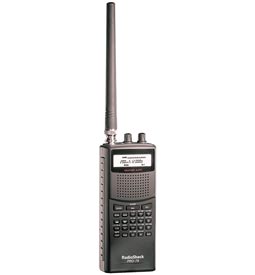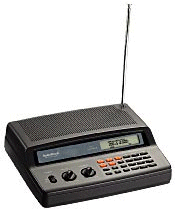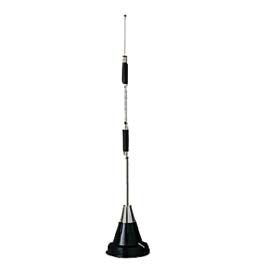Scanner Frequently Asked Questions
Section 1 - Scanner Basics
What is a scanner and why would I want / need one?
A scanner is a
radio receiver designed to allow you to listen to radio transmissions from the various
agencies and companies using radio communications in your area, such as police and fire
departments, ambulance services, government agencies, air, and amateur radio services.
Scanners let you scan these transmissions and are often preprogrammed with service search
banks for convenience. By pressing a single button, you can quickly search those
frequencies most commonly used by public service and other agencies without tedious and
complicated programming. Scanning is a growing hobby that lets you "listen in"
on public radio conversations and keep up on current local events as they are happening.
What different types of scanners are available?
Scanners are
broken down by physical types and scanning methods.
The three
physical types of scanners are Handheld, Mobile and Desktop. The primary differences
between them are shown in the table below. Range is dependent on the antenna used, and a
handheld scanner can usually be used in a mobile or desktop environment by attaching it to
a vehicle-mounted or base-station antenna (see Scanner Antennas and
Other Accessories).
| Scanner
Type |
Primary
Usage |
Power
Source |
Antenna |
Advantages |
Disadvantages |
| Handheld Scanners |
for Personal use |
Battery, AC/DC Jack |
Small Rubber Antenna |
Portability, Small size |
Shortest Range |
| Mobile Scanners |
for use in Vehicles |
DC Power Connections |
Vehicle-mounted Antenna |
Optimized for Vehicle Use |
Vehicle Only |
| Desktop Scanners |
for use at Home |
AC Power Connections |
Base-station Antenna |
Optimized for Desktop Use |
AC Power Only |
The three basic
scanning methods are Crystal-controlled, Conventional Programmable
and Trunk Tracking Programmable.
Early scanners
were crystal-controlled. These scanners had one or more internal slots for a crystal which allowed the radio to receive a single
frequency. Crystal-controlled scanners are not currently being sold. However, a number of
them turn up in pawn shops and garage sales. For example, the PRO-25 (Cat. No. 200-0106),
PRO-27 (Cat. No. 200-0108),
and PRO-53 (Cat. No. 200-0122) scanners were of this type. Generally, if you are looking
at a RadioShack scanner and it does not have a keypad or program button, it is probably
crystal-controlled. The disadvantage of crystal-controlled scanners is that they were slow
to tune, expensive to set-up for new frequency/channel activity, and they can not follow
the new trunked radio activity.
In the
mid-80's, programmable scanners were introduced. These use integrated circuits to allow
the radio to tune to a range of frequencies and were a marked improvement over
crystal-controlled scanners, which required the purchase and installation of different
crystals. Programmable scanners come with a wide range of features and capabilities and
are distinguished from one another by the following features:
The newest
innovation in scanners is Trunking Scanners. Trunking scanners are designed to track
Motorola® Type I and Type II (such as Smartnet™ and Privacy Plus™)
and hybrid analog trunking systems, plus GE/Ericsson (EDACS®) and EF Johnson®
(LTR®) type systems, which are extensively used in many communication systems.
Trunking communications systems let a large group of 2-way radio users (or even different
groups of 2-way radio users) efficiently use a set of frequencies. Instead of selecting a
specific frequency for a transmission, the user simply selects a talk group. The trunking
system automatically transmits the call on the first available frequency, and also sends a
code that uniquely identifies that transmission. Since the trunking system might send a
call and its response on different frequencies, it is difficult to listen to trunked
communications using a regular scanner. Trunking scanners monitor the data sent with a
2-way radio transmission so you can hear the call and response for that user and more
easily "follow" the conversation.
|
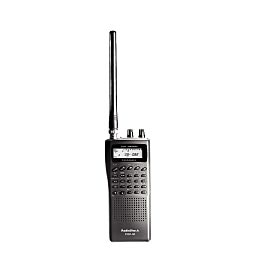
|
Memory Channels: 1000 Computer
Interface: No
Conversion
System: Triple Conversion
Size: 6
5/16" x 2 5/8" x 1 3/4"
Weather Alert:
Yes
Frequency
Range:
29-54, 108-174, 216-225, 406-512, 806-960 (excluding cellular) and 1240-1300 MHz
User's Manual Available
On-line
Back to Top
Back to Main Index |
|
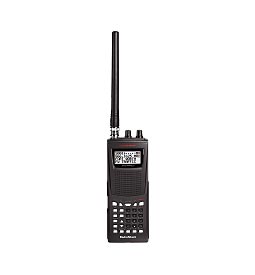
|
Memory Channels: 1000 Computer
Interface: PC interface, and can clone another PRO-95
Conversion
System: Triple Conversion
Weather Alert:
Yes
Frequency
Range:
25-54, 108-136.9875, 137-174, 216-225, 406-512, 806-960 (excluding cellular)
and 1240-1300 MHz
User's
Manual Available On-line
Back to Top
Back to Main Index |
|
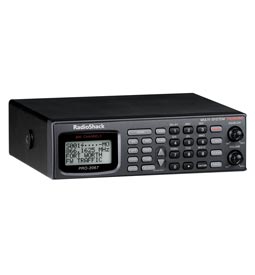
|
Memory Channels: 500 Computer
Interface: Can clone from a PRO-92 Handheld with included cable or by using the Software
and Cable (Available as Cat. No. 940-1223 or RSU 12204327). RSU items can be ordered
through your local RadioShack
Store or by calling the RadioShack Order Center at 800-843-7422.
Conversion
System: Triple Conversion
Size: 2" x
6 7/8" x 6 3/8"
Weather Alert:
Yes
Frequency
Range:
29-54, 108-174, 380-512, 806-960 MHz (excluding cellular)
User's
Manual Available On-line
Back to Top
Back to Main Index |
|

|
Memory Channels: 300 Computer
Interface: Scanner PC
Programming Kit (Cat. No. 20-048)
Conversion
System: Triple Conversion
Size: 3
3/8" x 8 7/16" x 6 9/16"
Weather Alert:
Yes
Frequency
Range:
29-54, 108-174, 216-225, 406-512, 806-960 (excluding cellular) and 1240-1300 MHz
User's
Manual Available On-line
Back to Top
Back to Main Index |
|
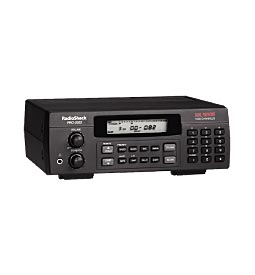
|
Memory Channels: 1000 Computer
Interface: with Cable (Cat. No.
26-117) and the Software (Available as Cat. No. 940-1222 or RSU 12236857). RSU items
can be ordered through your local
RadioShack Store or by calling the RadioShack Order Center at 800-843-7422.
Conversion
System: Triple Conversion
Size: 2
3/4" x 8 1/16" x 7 11/16"
Weather Alert:
Yes
Frequency
Range:
29-54, 108-174, 179.75-512, 806-956 (excluding cellular) and 1240-1300 MHz
User's Manual Available
On-line
Back to Top
Back to Main Index |
What can I legally listen to?
You can hear
police and fire departments, ambulance services, government agencies, private companies,
amateur radio services, aircraft, and military operations. It is legal to listen to almost
every transmission your scanner can receive. However, there are some electronic and wire
communications that are illegal to intentionally intercept. These include: telephone
conversations (cellular, cordless, or other private means of telephone signal
transmission), pager transmissions, and scrambled or encrypted transmissions. According to
the Federal Electronic Communications Privacy Act (ECPA), as amended, you could be fined
and possibly imprisoned for intentionally listening to, using, or disclosing the contents
of such a transmission unless you have the consent of a party to the communication (unless
such activity is otherwise illegal). These laws change from time to time and there might
be state or local laws that also affect legal scanner usage.
What accessories are available to improve my
scanning?
We offer
several accessories for our scanners, such as noise-blocking
headphones, antenna mounts and antennas.
Headphones
|
These RadioShack
Noise-Blocking Race Scanner Headphones are ideal for use in noisy locations like race
tracks. They effectively block out external noise —- up to 20 dB. Perfect for use
with the RadioShack Race Scanner. Easily adjustable volume control is conveniently located
on the left ear cup. The heavy-duty cord is tightly coiled so it stays out of your way.
Soft fluid-filled ear cushions and adjustable hook-and-loop headband provide a comfortable
fit for hours of listening comfort. Specifically designed for voice transmissions —-
wide 40-20,000Hz frequency response provides crisp, clear sound.
Product
Features:
- For use with all mono sources
- 1/8” gold-plated mono plug
- Neodymium magnets
- 8-foot cord
Back to Top
Back to Main Index |

|
Antenna Mounts
|
Product
Features:
- Window clip mounts antenna on glass
- Works with scanner or handy-talkie flex antennas
- For car, home, and travel
- 6 foot cord with BNC plug
Back to Top
Back to Main Index |
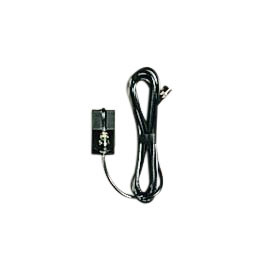 |
Antennas for Base Stations
|
Product
Features:
- Omnidirectional, rugged stainless steel construction
- Wide 25 - 1300 MHz receive coverage
- Transmits on 50, 144, 220, 440, 900 and 1296 MHz Ham bands
- Resonator and tunable whip for best 50 MHz performance
- About 44" high, overall
- Fits mast up to 1" in diameter
- Accepts PL-259 connector
(Use plug adapter 278-117
for scanners that have BNC connector)
Back to Top
Back to Main Index |
 |
|
Product
Features:
- Chrome-plated brass vertical element
- Covers 108 to 1300 MHz with peak performance in 152-470 MHz
- About 20" high
- Accepts PL-259 connector
(Use plug adapter 278-117
for scanners that have BNC connector)
Back to Top
Back to Main Index |
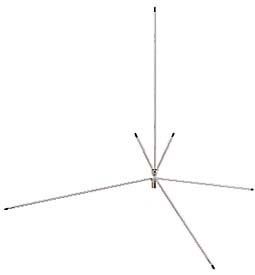 |
|
Product
Features:
- Covers 30 to 512MHz
- Extends to 40"
- Accepts PL-259 connector
(Use plug adapter 278-117
for scanners that have BNC connector)
Back to Top
Back to Main Index |
 |
Antennas for Mobile Stations
Antennas for Handheld Stations
|
Product
Features:
- Longer 9" length helps improve reception of
marginal signals
- BNC connector fits all RadioShack and most other handheld
scanners
- Can also be used with Ham HT's for transmitting on the 144
MHz or 440 MHz Ham bands.
Back to Top
Back to Main Index |
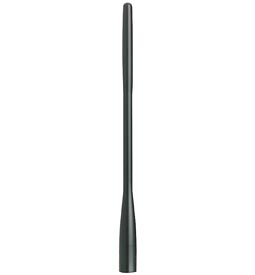 |
|
Product
Features:
- Receives 25 to 1300MHz
- Transmits on 144 MHz, 220 MHz and 440MHz Ham bands
- Nine sections
Back to Top
Back to Main Index |
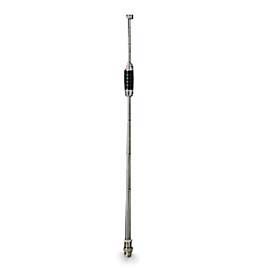 |
A broadcaster in my area now uses a digital system;
why can't I find a digital scanner?
Currently, most
radio systems are analog systems; however, some areas have begun using digital radio
systems. At this time, all of our scanners are analog only; we do not currently sell a
digital scanner.
What are birdies?
Birdies are
frequencies your scanner uses when it operates. These operating frequencies might
interfere with broadcasts on the same frequencies. If you program one of these
frequencies, you will hear only noise on that frequency. If the interference is not
severe, you might be able to turn up the squelch to cut
out the birdie. The most common birdies to watch for are listed below.
Birdie
Frequencies
| 31.05 MHz |
124.20 MHz |
| 41.40 MHz |
134.55 MHz |
| 51.75 MHz |
144.90 MHz |
| 113.85 MHz |
155.25 MHz |
You can use the
following procedure to check for birdies in your particular scanner.
- Remove the antenna.
- Turn the scanner on and set up a limit search for all bands
on the scanner.
- Be sure that the scanner is separated from possible signal
sources such as a PC, other transceivers, etc.
- Write down the frequencies where the scan stops or detects a
continuous noise signal. These are the Birdies.
Reception Notes
Reception of
the frequencies covered by your scanner is mainly "line of sight". That means
you usually cannot hear stations that are beyond the horizon. During the summer months you
may be able to hear stations in the 30-50 MHz range located several hundred or even
thousands of miles away. This is because of summer atmospheric conditions. This type of
reception is unpredictable but often very interesting! One very useful service is the National Weather Service's continuous
weather broadcast. These broadcasts contain weather forecasts and data for the areas
around the station, plus bulletins on any threatening weather conditions. These stations
use several frequencies; and in most areas of the country,
you can receive one of these frequencies.
General Troubleshooting
Check that you
are following the correct steps per the manual.
Check the
frequency to be sure you are entering it correctly.
Check the
scanner's frequency coverage to be sure that the scanner can receive that frequency.
Check the
scanner's reception ability by programming a known continuous voice broadcast such as NOAA on 162.4Mhz
– 162.55Mhz.
You can do this
by going to the Weather service band (if available on your scanner) or by programming a
limit search from 160Mhz – 170Mhz.
Reset the scanner as a last resort; this erases all memory
contents and resets the radio back to factory settings. The reset for most RadioShack
scanners is given below; however, for some models there is no reset and the only way to
reset the scanner is to remove power.
- Turn the scanner off.
- Push the 2 and 9 buttons and hold them down.
- Turn the scanner on while holding down the buttons.
- Release the 2 and 9 after the display shows CLEAR.
A Guide To The Action Bands
With the right
frequencies programmed into your scanner, you can monitor exciting events. With a little
investigation, you can find active frequencies in your community. We can give you some
general pointers, and you can take it from there. Please use caution and common sense when
you hear an emergency call. Never go to the scene of an emergency. It could be very
dangerous. Find out if there is a local club that monitors your community's frequencies.
Perhaps a local electronics repair shop that works on equipment similar to your scanner
can give you frequencies used by local radio services. A volunteer police department or
fire department can also be a good source for this information.
As a general
rule on VHF, most activity is concentrated between 153.785 and 155.98 MHz and then again
from 158.73 to 159.46 MHz. Here you find local government, police, fire and most such
emergency services. If you are near a railroad yard or major railroad tracks, look around
160.0 to 161.9 MHz for signals.
In some larger
cities, there has been a move to the UHF bands for emergency service. Here, most of the
activity is between 453.025 and 453.95 MHz and between 456.025 and 467.925 MHz.
In the UHF
band, frequencies between 456.025 and 459.95 MHz and between 465.025 and 469.975 MHz are
used by mobile units and control stations associated with base and repeater units that
operate 5 MHz lower (that is, 451.025 to 454.950 and 460.025 to 464.975 MHz). This means
that if you find an active frequency inside one of these spreads, you can look 5 MHz lower
(or higher) to find the base station/repeater for that service.
Typical
Band Usage
The following
is a brief listing of the typical services that use bands that a scanner can receive. This
listing helps you decide which ranges you would like to scan. These frequencies are
subject to change, and might vary from area to area. For a more complete listing refer to
the Police Call Radio Guide available at your local RadioShack store.
Abbreviations
MARS
Military Affiliate Radio System |
Ham
Amateur Radio |
Auto Emer.
Automobile Emergency |
BC.R
Broadcast Remote |
Bur.Recl.
Bureau of Reclamation |
CAP
Civil Air Patrol |
Agr. And
For.
Department of Agriculture & Forestry. |
F.D.
Fire Department |
For.Prod.
Forest Products |
Fors.Cons.
Forestry Conservation |
Govt.
Government |
Hwy.
Highway
Maintenance |
Land Tr.
Land Transportation |
L.Govt.
Local Government |
Mfg.
Manufacturers |
MIL
Military |
Mob.Tel.
Mobile Telephone |
Mot.P.
Motion Picture |
Buses.Trucks
Motor Carrier |
Nat.Park
National Parks |
Pet.
Petroleum |
P.D.
Police |
Power
Power Utilities |
Page
Radio Paging |
R.R.
Railroad |
Press
Relay Press |
St.P.D.
State Police |
Sp.Emer.
Special Emergency |
Sp.Ind.
Special Industry |
Taxi
Taxicab Radio |
Tel.Maint.
Telephone Maintenance |
U.S.C.G.S.
U.S. Coastal & Geodetic Survey |
USN
U.S. Navy |
U.S.W.B.
U.S. Weather Bureau |
|
|
Attention:
Your scanner may not be able to receive all frequencies and/or modes of reception that are
contained within this document. For complete information of your scanner's capabilities,
be sure to read your owner's manual completely.
A Guide To Frequencies
National Weather Frequencies
| 161.650 MHz |
161.775 MHz |
162.400 MHz |
162.425 MHz |
| 162.440 MHz |
162.450 MHz |
162.475 MHz |
162.500 MHz |
| 162.525 MHz |
162.550 MHz |
163.275 MHz |
|
Ham Radio Frequencies
Ham operators
often transmit emergency information when other communication methods break down. The
following chart shows some of the frequencies that Hams use.
| Wavelength (Meters) |
Frequency |
| 10-meter |
28.000-29.700 MHz |
| 6-meter |
50.000-54.000 MHz |
| 2-meter |
144.000-148.000 MHz |
| 70-cm |
420.000-450.000 MHz |
Citizens Band
| 1) 26.965 MHz |
9) 27.065 MHz |
17) 27.165 MHz |
25) 27.245 MHz |
33) 27.335 MHz |
| 2) 26.975 MHz |
10) 27.075 MHz |
18) 27.175 MHz |
26) 27.265 MHz |
34) 27.345 MHz |
| 3) 26.985 MHz |
11) 27.085 MHz |
19) 27.185 MHz |
27) 27.275 MHz |
35) 27.355 MHz |
| 4) 27.005 MHz |
12) 27.105 MHz |
20) 27.205 MHz |
28) 27.285 MHz |
36) 27.365 MHz |
| 5) 27.015 MHz |
13) 27.115 MHz |
21) 27.215 MHz |
29) 27.295 MHz |
37) 27.375 MHz |
| 6) 27.025 MHz |
14) 27.125 MHz |
22) 27.225 MHz |
30) 27.305 MHz |
38) 27.385 MHz |
| 7) 27.035 MHz |
15) 27.135 MHz |
23) 27.255 MHz |
31) 27.315 MHz |
39) 27.395 MHz |
| 8) 27.055 MHz |
16) 27.155 MHz |
24) 27.235 MHz |
32) 27.325 MHz |
40) 27.405 MHz |
United States Broadcast Bands
In the United
States, there are several broadcast bands. The standard AM and FM bands are probably the
most well known. There are also four television audio broadcast bands -- the lower three
transmit on the VHF band and the fourth transmits on the UHF band.
Frequency Range
Allocation
| VHF Television |
54.0 - 72.0 MHz |
| VHF Television |
76.0 - 88.0 MHz |
| Standard FM |
88.0 - 108.0 MHz |
| VHF Television |
174.0 - 216.0 MHz |
| UHF Television |
470.0 - 805.75 MHz |
International Broadcast Bands
Several
short-wave bands are allocated for international broadcasting because of the nature of
propagation of high frequencies. The bands are sometimes identified according to the
approximate wavelength of the signals in meters. Your scanner may receive the 11-meter
band, from 25.6 - 26.10 MHz.
Typical and Primary Band Usage, and Specified
Intervals
Typical
Band Usage
| HF
Band (3.0 - 30.0 MHz) |
| 25.00 - 28.63 MHz |
Mid Range |
| 25.00 - 28.63 MHz |
Mid Range |
| 28.00 - 29.70 MHz |
10-Meter Amateur Band |
| 29.70 - 29.90 MHz |
High Range |
| VHF Band (30.00 - 300.0 MHz) |
| 30.00 - 50.00 MHz |
Low range |
| 50.00 - 54.00 MHz |
6-Meter Amateur |
| 54.00 - 72.00 MHz |
FM-TV Audio Broadcast, Wide Band |
| 88.00 - 108.00 MHz |
FM Radio Broadcast, Wide Band |
| 108.00 - 136.00 MHz |
Aircraft |
| 138.00 - 144.00 MHz |
U.S. Government |
| 144.00 - 148.00 MHz |
2-Meter Amateur |
| 148.00 - 174.00 MHz |
High Range |
| 220.00 - 222.00 MHz |
New Mobile Narrow Band |
| 222.00 - 225.00 MHz |
1.3-Meter Amateur |
| 225.00 - 287.80 MHz |
Military Aircraft |
| UHF Band (300.00 MHz - 3.0 GHz) |
| 311.00 - 384.00 MHz |
Military Aircraft |
| 406.00 - 470.00 MHz |
U.S. Government |
| 420.00 - 450.00 MHz |
0.6-Meter Amateur |
| 450.00 - 470.00 MHz |
Low Range |
| 470.00 - 806.00 MHz |
FM-TV Audio Broadcast, Wide Band |
| 851.00 - 856.00 MHz |
Conventional Systems |
| 856.00 - 861.00 MHz |
Conventional/Trunked Systems |
| 861.00 - 866.00 MHz |
Trunked Systems |
| 866.00 - 869.00 MHz |
Public Safety |
| 869.00 - 894.00 MHz |
Common Carrier |
| 935.00 - 940.00 MHz |
Private Trunked |
| 940.00 - 941.00 MHz |
General Trunked |
Primary
Usage
As a general
rule, most of the radio activity is concentrated on the following frequencies:
| VHF Band (30.00 - 300.0 MHz) |
| 144.00 - 148.00 MHz |
2-Meter Amateur |
| 153.785 - 155.980 MHz |
Government, Police, and Fire |
| 158.730 - 159.460 MHz |
Emergency Services |
| 160.000 - 161.900 MHz |
Railroad |
| UHF Band (300.00 MHz - 3.0 GHz) |
| 440.00 - 450.00 MHz |
0.6-Meter Amateur Band FM Repeaters |
| 450.000 - 470.000 MHz |
Land Mobile "Paired"
Frequencies |
| 451.025 - 454.950 MHz |
Base Stations |
| 456.025 - 459.950 MHz |
Mobile Units |
| 460.025 - 464.975 MHz |
Repeater Units |
| 465.025 - 469.975 MHz |
Control Stations |
Note:
UHF remote control stations and mobile units typically operate at 5 MHz higher than their
associated base and relay repeater units.
Specified
Intervals
Frequencies in
different bands are accessible only at specific intervals. For example:
| VHF, HAM, and Government |
5.0 kHz steps |
| All Others |
12.5 kHz steps |
| Aircraft |
25.0 kHz steps |
Note:
Your scanner rounds the entered frequency to the nearest valid frequency. For example, if
you try to enter 151.473, the scanner might accept this as 151.470.
Band Allocation
To help you
decide which frequency ranges to search, use the following listing of the typical services
that use the frequencies your scanner receives. These frequencies are subject to change,
and might vary from area to area. For a more complete listing, refer to the
"Police-Call Radio Guide including Fire and Emergency Services", as well as
"Beyond Police Call", "Aeronautical Directory", "Nautical
Directory" and "Now you're Talking" texts available at your local RadioShack store.
Abbreviations
AIR
Aircraft |
BIFC
Boise (ID) Interagency Fire Cache |
BUS
Business |
CAP
Civil Air Patrol |
CB
Citizens Band |
CCA
Common Carrier |
CSB
Conventional Systems |
CTSB
Conventional/Trunked Systems |
FIRE
Fire Department |
HAM
Amateur (HAM) Radio |
GOVT
Federal Government |
GMR
General Mobile Radio |
GTR
General Trunked |
IND
Industrial Services |
MARI
Maritime Limited Coast |
MARS
Military Affiliate Radio System |
MED
Emergency/Medical Services |
MIL
U.S. Military |
MOV
Motion Picture/Video Industry |
NEW
Mobile Narrow |
NEWS
Relay Press |
OIL
Oil/Petroleum Industry |
POL
Police Department |
PUB
Public Services |
PSB
Public Safety |
PTR
Private Trunked |
ROAD
Road & Highway Maintenance |
RTV
Radio/TV Remote Broadcast Pickup |
TAXI
Taxi Services |
TELB
Mobile Telephone |
TELC
Cordless Telephones |
TELM
Telephone Maintenance |
TOW
Tow Trucks |
TRAN
Transportation Services |
TSB
Trunked Systems |
TVn
FM-TV Audio Broadcast |
USXX
Government Classified |
UTIL
Power & Water Utilities |
WTHR
Weather |
|
|
|
Frequency
Bands
High Frequency (HF) - (3 - 30 MHz)
Very High Frequency (VHF) - (30 - 300 MHz)
Ultra High Frequency (UHF) - (300 MHz - 3 GHz)
| High Band - (25.00 - 27.36 MHz) |
| 25.020 - 25.320 |
IND |
| 25.870 - 26.470 |
RTV |
| 26.62 |
CAP |
| 26.966 - 27.405 |
CB |
| 27.430 - 27.630 |
BUS |
| 10-Meter
Amateur Band - (28.0 - 29.7 MHz) |
| 28.000 - 29.700 |
HAM |
Low Band - (29.7 - 50 MHz - in 5 kHz steps) |
| 29.700 - 29.790 |
IND |
| 29.900 - 30.550 |
GOVT,
MIL |
| 30.580 - 31.980 |
IND,
PUB |
| 32.000 - 32.990 |
GOVT,
MIL |
| 33.020 - 33.980 |
BUS,
IND, PUB |
| 34.010 - 34.990 |
GOVT,
MIL |
| 35.020 - 35.980 |
BUS,
PUB, IND, TELM |
| 36.000 - 36.230 |
GOVT,
MIL |
| 36.250 |
Oil
spill clean up |
| 36.270 - 36.990 |
GOVT,
MIL |
| 37.020 - 37.980 |
PUB,
IND |
| 38.000 - 39.000 |
GOVT,
MIL |
| 39.020 - 39.980 |
PUB |
| 40.000 - 42.000 |
GOVT,
MIL, MARI |
| 42.020 - 42.940 |
POL |
| 42.960 - 43.180 |
IND |
| 43.220 - 43.680 |
TELM,
IND, PUB |
| 43.700 - 44.600 |
TRAN |
| 44.620 - 46.580 |
POL,
PUB |
| 46.600 - 46.990 |
GOVT, TELC |
| 47.020 - 47.400 |
PUB |
| 47.420 |
American Red Cross |
| 47.440 - 49.580 |
IND,
PUB |
| 49.610 - 49.990 |
MIL,
TELC |
6-Meter
Amateur Band (50 - 54 MHz) |
| 50.00 - 54.00 |
HAM |
| FM-TV
Audio Broadcast, Wide Band (54 - 72 MHz) |
| 59.750 |
TV |
Channel 2 |
| 65.750 |
TV |
Channel 3 |
| 71.750 |
TV |
Channel 4 |
| Land
Mobile Service Band (72 - 76 MHz) |
| FM-TV
Audio Broadcast, Wide Band (76 - 88 MHz) |
| 81.750 |
TV |
Channel 5 |
| 87.750 |
TV |
Channel 6 |
| FM
Radio Broadcast, Wide Band (88 - 108 MHz) |
| Aircraft
Band (108 - 136 MHz) |
| 108.000 - 121.490 |
AIR |
| 121.500 |
AIR
Emergency |
| 121.510 - 136.000 |
AIR |
| U.
S. Government Band (138 - 144 MHz) |
| 137.000 - 144.000 |
GOVT, MIL |
| VHF-Hi
Band (148 - 174 MHz) |
| 148.050 - 150.345 |
CAP, MARS, MIL |
| 150.775 - 150.790 |
MED |
| 150.815 - 150.965 |
TOW |
| 150.980 |
Oil Spill
Clean Up |
| 150.995 - 151.130 |
ROAD |
| 151.145 - 151.475 |
POL |
| 151.490 - 151.955 |
IND, BUS |
| 151.985 |
TELM |
| 152.030 - 152.240 |
TELB |
| 152.270 - 152.465 |
IND, TAXI |
| 152.480 |
BUS |
| 152.510 - 152.840 |
TELB |
| 152.870 - 153.020 |
IND, MOV |
| 153.035 - 153.175 |
IND, OIL, UTIL |
| 153.740 - 154.445 |
PUB, FIRE |
| 154.490 - 154.570 |
IND, BUS |
| 154.585 |
Oil Spill
Clean Up |
| 154.600 - 154.625 |
BUS |
| 154.665 - 156.240 |
MED, ROAD, POL, PUB |
| 165.255 |
OIL |
| 156.275 - 157.425 |
MARI |
| 157.450 |
MED |
| 157.470 - 157.515 |
TOW |
| 157.530 - 157.725 |
IND, TAXI |
| 157.740 |
BUS |
| 157.770 - 158.100 |
TELB |
| 158.130 - 158.460 |
BUS, IND, OIL, TELM,
UTIL |
| 158.490 - 158.700 |
TELB |
| 158.730 - 159.465 |
POL, PUB, ROAD |
| 159.480 |
OIL |
| 159.495 - 161.565 |
TRAN |
| 161.580 |
OIL |
| 161.600 - 162.000 |
MARI, RTV |
| 162.0125 - 162.35 |
GOVT, MIL, USXX |
| 162.400 - 162.550 |
WTHR |
| 162.5625 - 162.6375 |
GOVT, MIL, USXX |
| 162.6625 |
MED |
| 162.6875 - 163.225 |
GOVT, MIL, USXX |
| 163.250 |
MED |
| 163.275 - 166.225 |
GOVT, MIL, USXX |
| 166.250 |
GOVT, RTV, FIRE |
| 166.275 - 169.400 |
GOVT, BIFC |
| 169.445 |
Wireless Microphones |
| 169.500 |
GOVT |
| 169.505 |
Wireless Microphones |
| 169.55 - 169.9875 |
GOVT, MIL, USXX |
| 170.000 |
BIFC |
| 170.025 - 170.150 |
GOVT, RTV, FIRE |
| 170.175 - 170.225 |
GOVT |
| 170.245 - 170.305 |
Wireless Microphones |
| 170.350 - 170.400 |
GOVT, MIL |
| 170.425 - 170.450 |
BIFC |
| 170.475 |
PUB |
| 170.4875 - 173.175 |
GOVT, PUB, Wireless Microphones |
| 173.225 - 173.375 |
MOV, NEWS, UTIL |
| 173.3875 - 178.5375 |
MIL |
| 173.5625 - 173.5875 |
MIL
Medical/Crash Crews |
| 173.60 - 173.9875 |
GOVT |
| FM-TV
Audio Broadcast, VHF Wide Band (174 - 216 MHz) |
| 179.750 |
TV |
Channel 7 |
| 185.750 |
TV |
Channel 8 |
| 191.750 |
TV |
Channel 9 |
| 197.750 |
TV |
Channel 10 |
| 203.750 |
TV |
Channel 11 |
| 209.750 |
TV |
Channel 12 |
| 215.750 |
TV |
Channel 13 |
| New
Mobile Narrow Band (220 - 222 MHz) |
| 220.000 - 222.000 |
NEW |
| 1.3-Meter
Amateur Band (222 - 225 MHz) |
| 222.000 - 225.000 |
HAM |
| Military
Aircraft Band (237.9 - 287.8 MHz) |
| 237.900 |
Coast Guard Search & Rescue |
| 239.800 |
FAA Weather |
| 241.000 |
Army Aircraft |
| 243.000 |
Military Aircraft Emergency |
| 255.400 |
FAA Flight Service |
| 257.800 |
Civilian Towers |
| 287.800 |
Coast Guard Air/Sea Rescue |
| Military Aircraft Band (319.1 - 383.9 MHz) |
| 319.100 |
FAA Traffic Control |
| 321.000 - 336.600 |
Air Force |
| 342.500 - 344.600 |
FAA Weather |
| 346.400 - 364.200 |
Air Force Traffic Control |
| 381.800 - 383.900 |
Coast Guard |
| U.S.
Government Band (406 - 420 MHz) |
| 406.125 - 419.975 |
GOVT, USXX |
| 70-cm
Amateur Band (420 - 450 MHz) |
| 420.000 - 450.000 |
HAM |
| Low
Band (450 - 470 MHz) |
| 450.050 - 450.925 |
RTV |
| 451.025 - 452.025 |
IND, OIL, TELM, UTIL |
| 452.0375 - 453.00 |
IND, TAXI, TRAN, TOW,
NEWS |
| 453.0125 - 453.9875 |
PUB |
| 454.000 |
OIL |
| 454.025 - 454.975 |
TELB |
| 455.050 - 455.925 |
RTV |
| 457.525 - 457.600 |
BUS |
| 458.025 - 458.175 |
MED |
| 460.0125 - 460.6375 |
FIRE, POL, PUB |
| 460.650 - 462.175 |
BUS |
| 462.1875 - 462.450 |
BUS, IND |
| 462.4625 - 462.525 |
IND, OIL, TELM, UTIL |
| 462.550 - 462.725 |
GMR |
| 462.750 - 462.925 |
BUS |
| 462.9375 - 463.1875 |
MED |
| 463.200 - 467.925 |
BUS |
Family Radio Service (462.5625 - 467.7125
MHz)
(Channels 1 - 14) |
| 462.5625 |
FRS |
Channel 1 |
| 462.5875 |
FRS |
Channel 2 |
| 462.6125 |
FRS |
Channel 3 |
| 462.6375 |
FRS |
Channel 4 |
| 462.6625 |
FRS |
Channel 5 |
| 462.6875 |
FRS |
Channel 6 |
| 462.7125 |
FRS |
Channel 7 |
| 467.5625 |
FRS |
Channel 8 |
| 467.5875 |
FRS |
Channel 9 |
| 467.6125 |
FRS |
Channel 10 |
| 467.6375 |
FRS |
Channel 11 |
| 467.6625 |
FRS |
Channel 12 |
| 467.6875 |
FRS |
Channel 13 |
| 467.7125 |
FRS |
Channel 14 |
FM-TV Audio Broadcast, UHF Wide Band (470 - 805.750 MHz)
(Channels 14 - 69 in 6 MHz steps) |
| 475.750 |
TV |
Channel 14 |
| 481.750 |
TV |
Channel 15 |
| 487.750 |
TV |
Channel 16 |
| 493.750 |
TV |
Channel 17 |
| 499.750 |
TV |
Channel 18 |
| 505.750 |
TV |
Channel 19 |
| 511.750 |
TV |
Channel 20 |
| 517.750 |
TV |
Channel 21 |
| 523.750 |
TV |
Channel 22 |
| 529.750 |
TV |
Channel 23 |
| 535.750 |
TV |
Channel 24 |
| 541.750 |
TV |
Channel 25 |
| 547.750 |
TV |
Channel 26 |
| 553.750 |
TV |
Channel 27 |
| 559.750 |
TV |
Channel 28 |
| 565.750 |
TV |
Channel 29 |
| 571.750 |
TV |
Channel 30 |
| 577.750 |
TV |
Channel 31 |
| 583.750 |
TV |
Channel 32 |
| 589.750 |
TV |
Channel 33 |
| 595.750 |
TV |
Channel 34 |
| 601.750 |
TV |
Channel 35 |
| 607.750 |
TV |
Channel 36 |
| 613.750 |
TV |
Channel 37 |
| 619.750 |
TV |
Channel 38 |
| 625.750 |
TV |
Channel 39 |
| 631.750 |
TV |
Channel 40 |
| 637.750 |
TV |
Channel 41 |
| 643.750 |
TV |
Channel 42 |
| 649.750 |
TV |
Channel 43 |
| 655.750 |
TV |
Channel 44 |
| 661.750 |
TV |
Channel 45 |
| 667.750 |
TV |
Channel 46 |
| 673.750 |
TV |
Channel 47 |
| 679.750 |
TV |
Channel 48 |
| 685.750 |
TV |
Channel 49 |
| 691.750 |
TV |
Channel 50 |
| 697.750 |
TV |
Channel 51 |
| 703.750 |
TV |
Channel 52 |
| 709.750 |
TV |
Channel 53 |
| 715.750 |
TV |
Channel 54 |
| 721.750 |
TV |
Channel 55 |
| 717.750 |
TV |
Channel 56 |
| 733.750 |
TV |
Channel 57 |
| 739.750 |
TV |
Channel 58 |
| 745.750 |
TV |
Channel 59 |
| 751.750 |
TV |
Channel 60 |
| 757.750 |
TV |
Channel 61 |
| 763.750 |
TV |
Channel 62 |
| 769.750 |
TV |
Channel 63 |
| 775.750 |
TV |
Channel 64 |
| 781.750 |
TV |
Channel 65 |
| 787.750 |
TV |
Channel 66 |
| 793.750 |
TV |
Channel 67 |
| 799.750 |
TV |
Channel 68 |
| 805.750 |
TV |
Channel 69 |
Note:
Some cities use the 470 - 512 MHz band for land/mobile service.
| Conventional
Systems Band - Locally Assigned |
| 851.0125 - 855.9875 |
CSB |
| Conventional/Trunked
Systems Band - Locally Assigned |
| 856.0125 - 860.9875 |
CTSB |
| Trunked
Systems Band - Locally Assigned |
| 861.0125 - 865.9875 |
TSB |
| Public
Safety Band - Locally Assigned |
| 866.0125 - 868.9875 |
PSB |
| Common
Carrier |
| 869.010 - 894.000 |
CCA |
| Private
Trunked |
| 935.0125 - 939.9875 |
PTR |
| General
Trunked |
| 940.0125 - 940.9875 |
GTR |
Frequency Conversion
The tuning of a
station can be expressed in frequency (kHz or MHz) or in wavelength (meters). The
following information can help you make the necessary conversions.
- 1 MHz (million) = 1,000 kHz (thousand)
To convert MHz
to kHz, multiply by 1,000:
- 9.62 MHz x 1000 = 9620 kHz
To convert from
kHz to MHz, divide by 1,000
- 2780 kHz / 1000 = 2.780 MHz
To convert MHz
to meters, divide 300 by the number of megahertz
- 300 / 7.1 MHz = 42.25 meters
Image Reception
Radios work by
simple mathematics. For example, most tune to a frequency by mixing that frequency with
another (local oscillator) frequency which is slightly different. This mixing process
primarily gives us the two original frequencies, their sum, and their difference. Well,
the radio's Intermediate Frequency (IF) filter normally passes
either the sum or difference frequency, and this is then processed into the sound we hear.
Because nothing is perfect, certain "harmonics" will also get through if they
are strong enough. For example, if a radio's IF is 10.7 MHz, we might be able to tune to a
frequency 21.4 MHz (2 x IF) above (or below, depending on the radio's design) a strong
signal and hear it! This is more evident in a dual-conversion
radio than a triple-conversion radio, because
the triple-conversion radio's 1st intermediate frequency is quite high. This causes the
image to be so far off frequency that it is easy to effectively filter it out.
Just because a
radio doesn't receive something which another does is not necessarily an indication of a
problem. The one radio may simply not be "tricked" into picking up an image! This rejection of undesired signals is one reason that a
triple-conversion receiver costs more than a similar dual-conversion model. If you are
more interested in finding more out about radios and radio operation, a good location to
start looking is your local public library. You might also wish to contact the ARRL, as they are an excellent source of
informative texts on the subject.
Additional On-line Information
Glossary
| Base Station: |
A scanner or other
two-way radio which is non-mobile, often connected to a larger, outdoor antenna. |
| Birdie: |
A false/unwanted
signal produced inside the scanner. |
| Channel: |
A memory location
used to store a single frequency. |
| Conventional Scanning: |
Following
conversations that are broadcast on manually tuned radios. |
| Crystal: |
A component which
allows a crystal-controlled scanner to receive a particular frequency. |
| dB, decibel: |
Unit used to express
relative differences in noise level or signal strength. |
| Discone: |
An antenna which has
the horizontal elements connected to the shield and the cone connected to the coax center
conductor, so that the actual configuration is an upside down half-bow-tie. |
| Dual-conversion: |
A method using a
receive circuit with two stages and two intermediate frequencies to extract the data
signal from the carrier. |
| Frequency: |
The number of cycles
(Hertz) used as a carrier for a particular data signal. |
| Frequency Band: |
A particular
frequency range used for a particular purpose. |
| Frequency Step: |
The increment
between displayed frequencies on a digitally-tuned scanner. |
| Harmonic: |
Describes a
frequency which has a smaller amplitude and is a multiple of a larger frequency (for
example, 480 MHz is the second harmonic of 240 MHz and the third harmonic of 120 MHz). |
| Hyperscan: |
A faster scan method
available on some scanners. |
| GHz (gigahertz): |
A unit of frequency
equal to 1000 MHz, 1,000,000 kHz
or 1,000,000,000 Hz. |
| Hz
(Hertz): |
A unit of frequency
equal to one cycle per second. |
| Image: |
A "false"
signal generated by the scanner during reception and demodulation. |
| Intermediate Frequency (IF): |
A frequency used in
the demodulation process (see Dual-conversion and Triple-conversion). |
| kHz (kilohertz): |
A unit of frequency
equal to 1000 Hz. |
| Lock-out: |
To mark a channel to
not be scanned. |
| MHz (megahertz): |
A unit of frequency
equal to 1000 kHz or 1,000,000 Hz. |
| Priority Channel: |
A channel which is
scanned regularly during normal scanning. |
| Reset: |
Return the scanner
to factory settings. |
| Reinitialize: |
Return the scanner
to factory settings. |
| RX: |
Shorthand for
Receive or Receiving. |
| Scanner: |
A radio that can
tune quickly and/or automatically to a wide range of frequencies used by hobbyists to
monitor police, fire, and other emergency services. |
| Service Band: |
A particular
frequency range used for a particular purpose. |
| SMR: |
Acronym for "Service
Maintenance Repeater", indicating that radio
operators must be a member of that club to transmit to that repeater. |
| Squelch: |
Allows you to set
the minimum strength signal that will be received. |
| Super-heterodyne:
|
Describes a
transmitting encoding method which mixes a carrier and oscillator frequency. |
| Triple-conversion: |
A method using a
receive circuit with three stages and three intermediate frequencies to extract the data
signal from the carrier. |
| Trunk tracking: |
Following
conversations that are broadcast on radios automatically tuned by a computer. |
| TX: |
Shorthand for
Transmit or Transmitting. |
| UHF: |
The frequencies
between 300 MHz and 3 GHz. |
| VHF: |
The frequencies
between 30 MHz and 300 MHz. |
Copyright© RadioShack
Corporation 2001. All rights reserved.
Privacy Policy
